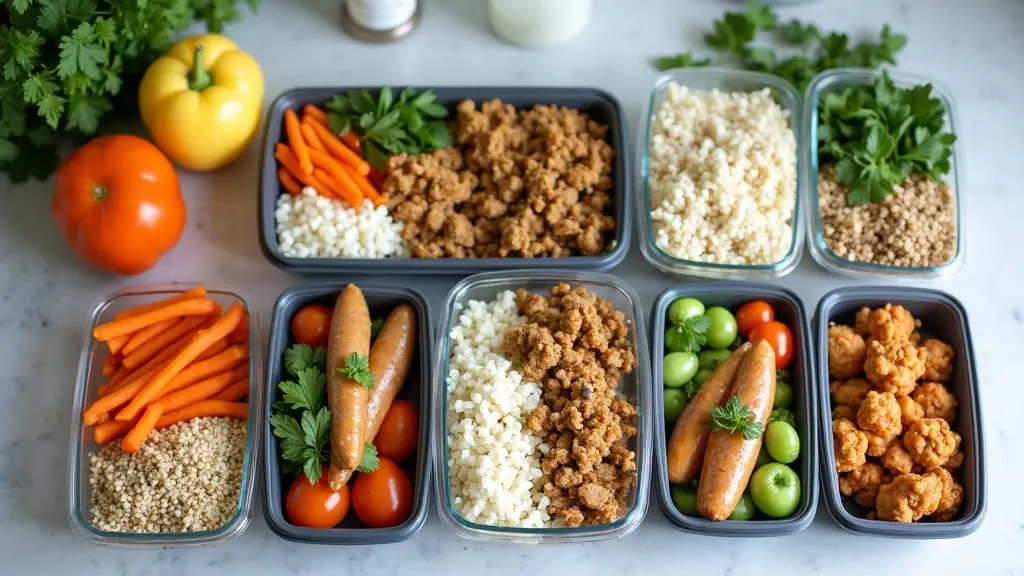If you’re just starting to think about eating healthier, meal planning might feel a bit confusing at first. I’ve definitely been there, feeling stuck staring at an empty fridge or falling back on takeout a little too often. Weekly healthy meal plans for beginners can take away a lot of the stress, making healthier eating feel much more doable and (believe it or not) even enjoyable. I’m sharing my personal approach and some practical tips to help you get set up, so you can build better habits without burning out.

How to Start Eating Healthy for Beginners Meal Plan
Kicking things off with a healthy meal plan doesn’t mean overhauling your whole lifestyle overnight. I’ve found that starting small makes a much bigger difference than going all in and losing steam by midweek. The most beginnerfriendly approach is to focus on basics: build balanced simple vegan meals, include affordable ingredients you actually enjoy, and don’t forget that convenience is important too.
Here’s what typically works well for just about anyone:
- Pick the meals you want to prep: You don’t have to make all your breakfasts, lunches, and dinners from scratch. Start with just one meal of the day that’s tricky for you, maybe lunches, if you’re tired of rushed sandwiches or expensive takeout.
- Choose simple recipes: Look for recipes with minimal steps and familiar ingredients. Stirfries, sheet pan meals, and grain bowls are all beginnerfriendly and flexible.
- Plan for leftovers: Doubling a dinner recipe means you’ve got a quick lunch the next day without extra work.
One of my best early easy meal prep hacks was making a big batch of grains (like brown rice or quinoa) at the beginning of the week. I portion it out so I can use it for everything from grain bowls to stirfries and wraps. Having that one component ready saves a ton of time. As you continue, you’ll find you can mix in some variety by trying new grains like farro or bulgur too, keeping your meals exciting and not repetitive.
Understanding the 3 3 3 Rule Eating
The 3 3 3 rule of eating gets mentioned a lot in beginner meal plans. It makes healthy eating way easier to remember, and it’s pretty popular because of the simple math. Here’s how it breaks down:
- 3 meals a day
- 3 different food groups per meal (usually a mix of protein, carbs, and vegetables or fruit)
- 3 different colors of food per meal (which helps with variety and nutrition)
Trying out the 3 3 3 rule helped me gut-check my plates, and I realized how easy it is to create more balanced meals. For example, a quick bowl with grilled chicken (protein), brown rice (carb), and roasted broccoli plus cherry tomatoes (colors) already covers the basics. Meals like this are pretty hard to mess up, and you end up eating a bigger variety of nutrients each day. Sticking to this guideline can also turn grocery shopping into an eye-opening experience, as you start spotting colorful fruits and veggies you might not have grabbed before.
How to Eat Healthy Food Every Day for Beginners
Consistency is the key to any healthy habit. When you’re not sure where to start, simple swaps and prepping ahead are super useful. I’ve tried and tested a few tips to keep myself on track:
- Keep healthy snacks in reach: Putting precut veggies, hummus, or trail mix at eye level in the fridge makes it easier to avoid snack cravings for chips or cookies.
- Batch prep ingredients: I like to chop extra veggies at once or roast a tray of sweet potatoes to toss into meals during the week. Adding a mix of proteins like baked tofu or hardboiled eggs can help too.
- Have a “template” meal: For me, that’s a big salad with greens, protein (beans, chicken, or fish), cooked grains, and a homemade dressing. I just change up the toppings to avoid boredom.
- Stock up on basics: Whole grains like oats, rice, beans, and frozen veggies can stretch a lastminute dinner into something filling and nutritious.
I also like to write out three or four “goto” meals on my phone’s notes app. That way, when I’m feeling stuck, I have instant inspiration for healthy options I know I’ll actually enjoy.
How to Plan a Week of Meals for Beginners
Weekly meal planning isn’t about making complicated spreadsheets. I keep it simple by following a loose structure, and you can tailor this however you want. The trick is picking themes or styles that match your taste and routine.
- Choose a theme for each night: For example, Meatless Monday, Taco Tuesday, Pasta Wednesday, and so on. It helps narrow down recipes and makes grocery shopping way easier. Themes can even reflect favorite cuisines like Italian night, Asianinspired day, or a breakfastfordinner twist.
- Write out your meals: I just use a notebook or my phone. List breakfast, lunch, and dinner ideas for the week. Even just five dinners planned out with room for flexibility keeps things stress-free.
- Make a grocery list: Go through each recipe and jot down what you need. Group things by section (produce, dairy, etc.) to save time at the store.
- Add in prepped extras: Chopping or cooking some ingredients (like onions or a batch of hardboiled eggs) ahead of time can make assembling meals during the week super quick.
A typical week for me might look like this:
- Monday: Veggie stirfry over brown rice
- Tuesday: Chicken tacos with black beans and shredded lettuce
- Wednesday: Turkey chili with whole grain bread
- Thursday: Pasta with roasted veggies and marinara sauce
- Friday: DIY grain bowls with whatever leftovers are in the fridge
I try to leave room for spontaneous meals or leftovers on the weekend, which keeps things from feeling too rigid. You might also plan one night for trying a new recipe or even letting a friend or family member choose the menu, mixing in some variety and fun to the week with family-friendly meals.
Beginner Meal Prep Tips for a Healthy Week
Meal prep might seem like a lot of work upfront, but once you get into a rhythm, it actually saves a bunch of time and energy during the busy parts of your week. Here’s what I find works best for most people:
- Start with one or two meals: Don’t overwhelm yourself by trying to prep an entire week’s worth of food at once. Begin with just lunches or dinners.
- Focus on batchfriendly recipes: Curries, grain salads, frittatas, and soups hold up really well throughout the week. Consider prepping a couple different proteins, like chicken and beans, so you can mix up your meals but not spend all day in the kitchen.
- Use containers you like: Investing in some good quality glass or plastic meal prep containers helps a lot with both portion control and keeping food fresh.
- Don’t forget seasoning: Having a few favorite spice blends or herbal seasonings can seriously give a boost to the flavor of simple foods. Even a squeeze of lemon or a dash of hot sauce can wake up leftovers.
- Label everything: Write the prep date and contents on your containers. This avoids mystery meals at the end of the week and helps you track down a certain dish quickly.
Things to Consider Before Starting a Weekly Healthy Meal Plan
The first week or two of meal planning is usually trial and error. I always suggest paying attention to what you like, and what you definitely get tired of. Here are some helpful things to keep in mind:
- Time and energy: Some weeks are much busier than others. If you’re low on time, look for recipes that use fewer ingredients or require less handson cooking. Sheet pan dinners, slow cooker meals, or fiveingredient dishes come in handy.
- Special diets: If you have specific dietary needs, it helps to flag those affordable ingredients when making your grocery list. There’s a big range of resources online for glutenfree, dairyfree, lowercarb, or plantbased diets.
- Food waste: Only buy what you know you’ll use and plan to use the most perishable stuff first. Freezing extra portions is a good move if you get tired of eating the same meal on repeat.
- Staying flexible: Not every meal will go as planned, and that’s totally fine. Being flexible can actually keep you from getting burned out in the long run.
Quick Notes on Food Safety and Storage
Getting a handle on food safety is really important. I always label containers with the prep date and store cooked food within two hours of cooking. Most meal preps keep well for up to four days in the fridge. Still, use your senses to judge freshness; if it smells or looks off, toss it. Freezing some meals in singleserve portions can help reduce waste and provide easy grabandgo lunches on busy days.
BudgetFriendly Meal Planning for Beginners
Healthy eating doesn’t have to break the bank. Some of my favorite healthy meals come from inexpensive basics like canned beans, oats, frozen veggies, and eggs. Shopping sales, buying in bulk, or choosing cheaper proteins (like lentils or chicken thighs) can help keep your food budget in check. Buying produce that’s in season is more affordable, and frozen fruits or vegetables work just as well as fresh for many recipes, making it easy to keep healthy choices on hand without spending more.
Healthy Meal Planning FAQs
Here are a few of the top questions I see from beginners who want to get into healthy meal planning:
How do I keep my meals from getting boring?
Rotating new sauces, seasonings, or even trying out one new recipe a week will boost the variety a lot. Pinterest and food blogs are super useful for fresh ideas.
Can I meal prep if I don’t like to cook?
Absolutely! There are tons of “nocook” healthy meal ideas, including salads, wraps, and snack boxes. Prepping ingredients (like washing greens or chopping veggies) still gives you a head start on healthy eating, no chef experience required.
Should I count calories when planning meals?
You really don’t need to, especially in the beginning. Focusing on variety, portion control, and using plenty of veggies or lean proteins can do wonders, without tracking every bite.
How can I handle picky eaters in the household?
Let everyone pick one dinner each week or keep meal components separate (for example, make a buildyourown taco or grain bowl night) so people can mix together their favorite toppings.
Building LongTerm Healthy Habits Through Meal Planning
Building lasting habits with weekly meal planning isn’t about being perfect or eating exactly the same foods every week. It’s about making it easier to choose healthy meals most of the time and having a plan in place to support yourself on busy days. Experiment a bit, celebrate your small wins, like packing all your lunches for one week, and tweak your plan as you stumble upon your style. Even tiny consistent changes can add up over time. So just get started and see what works best for you! If you stick with it, you’ll soon find that healthy eating feels like second nature—and meal planning becomes a tool you can rely on to keep life simpler and more enjoyable.
